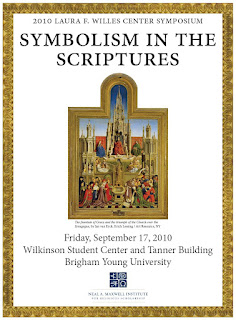
Last week I had the opportunity to attend the 2010 Laura F. Willes Center Symposium entitled "Symbolism in the Scriptures" held September 17th on the BYU campus. There were many fascinating presentations given and I wanted to give synopses for a few of the presentations that I enjoyed the most.
The first presentation that I wanted to write about was given by Daniel Belnap. His talk was entitled "Clothed with Salvation: The Garden, the Veil & Christ".
He explained that his lecture was going to be a look at symbolism within a ritual context and he began by citing the story of Tabitha found in Acts 9:36-42. Tabitha was a woman of Joppa who became sick and died. She was very important to the Christian community there and when the local disciples heard that Peter was in nearby Lydda they sent two men to ask him to come. When Peter arrived the widows of Joppa showed him the clothing that Tabitha had made for them. They did this to show Peter how important Tabitha was to them. Peter then sent everyone out of the room, shut the doors and raised Tabitha from the dead.
Daniel Belnap then explained the symbolism that is attached to clothing. Clothing is related to our self-concept. It helps us to develop and maintain notions of who we are and what roles we play in society. Clothing is highly visible and tangible and facilitates our move from one role to another. Clothing also marks the boundary between self and society.
He then went on to discuss the concept nakedness as contrasted with nudity. Nakedness is not necessarily the same as nudity. Nudity is simply the lack of clothing while nakedness is something that is socially constructed. Nakedness is not instinctive. We learn as children to be ashamed of our bodies. Nakedness is not inherently negative, on the contrary it helps society and serves a social function.
The Garden
In the Garden of Eden Adam and Eve were naked but not ashamed. This was not necessarily a good thing and needed to be corrected. Lehi taught in 2 Nephi 2 that if Adam and Eve had remained that way they would not have progressed. Adam and Eve would have had no posterity and would have never experienced joy but would have remained in their innocent state forever. After partaking of the fruit of the Tree of Knowledge of Good and Evil Adam and Eve became ashamed and made for themselves aprons of fig leaves to cover their nakedness. These aprons are the first clothing mentioned in the scriptures. Adam and Eve used this clothing to identify themselves. Having the ability to clothe implies the person doing the clothing has power.
The Nazis used clothing to control the Jews. They made the Jews wear yellow stars to identify and marginalize them. In the concentration camps they forced the Jews to remove their clothing in order to make them feel helpless and vulnerable. In prisons inmates are forced to wear a uniform in order to define their role within the prison.
After making their aprons Adam and Eve hid. Using fig leaves for clothing would have acted as camouflage in the garden. The fact that they hid from God shows that they realized their relationship with God had changed. They can no longer interact with him in the same way. After the consequences of their choice was decreed Adam and Eve get new clothing. This clothing is made and given to them by God. Their receipt of the new clothing implies that Adam and Eve's definition of themselves isn't totally accurate. God is the one who defines who they are. Their new clothing is a symbol of what God means them to be.
In this story there is also an interesting play on words. Genesis 3:1 describes the serpent as "subtil". In the Hebrew text the word that is translated into "subtil" is ערום (arum) which is a participle of ערם (aram) which means "to make bare". This is a clever way of saying that Satan is the most naked before the Lord. Satan crawls around in the dirt just as slaves did anciently. Slaves were always given menial tasks which usually entailed them working in the dirt.
The Veil
In Numbers 4:5 the Lord instructs the Levites to wrap the ark in the veil when the tabernacle was being dismantled and transported. The veil in this instance acts as clothing for the ark. It covers the ark and defines it. The high priest also wore a representation of the veil. Exodus 28:5-6,8,15,33 explains that both the veil and the garments of the high priest were composed of similar materials. The veil was placed between the Holy of Holies and the Holy Place to protect the sanctity of the Holy of Holies and the garments of the high priest served a similar function. Also the clothing of the high priest and the veil allowed the high priest to move between the spaces in the temple without dying.
Christ
The story of the Luke 8:26-36 was discussed next. In this story the Savior comes upon a man possessed of devils. Luke makes the point that the man in not wearing any clothing. The person has lost his identity. When the Savior asks his name the man gives his name as "legion" which is not a real name. Jesus casts the devils out of the man and the man is clothed and in his right mind. The Savior not only invests the man with clothing but restores his identity to him.
Dan Belnap then briefly discussed a few other concepts with associated scripture references which are given below:
Atonement & Investiture:
Revelation 7:14
Alma 5:21,27
3 Nephi 27:19
Eternal Life as Investiture
D&C 29:13
Christ as Clothing
Mark 5:29
Romans 13:14
Galatians 3:27
Hebrews 10:19
Those invested in turn invest others
D&C 133:32
In future postings I will write about some of the other presentations.










